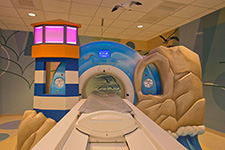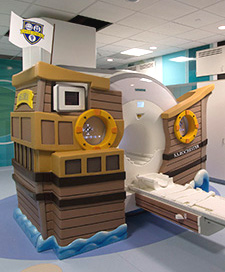Tests & Procedures
Tests & Procedures
We offer a full range of the most up-to-date diagnostic studies and therapies available today for all types of childhood cancers and blood disorders.
Diagnostic Tests

CT Scan - Computed Tomography
- CT or computed tomography scan uses x-rays taken from different angles. A computer analyzes this data to produce detailed cross-sectional images of the body. These pictures can be stacked in layers to form three-dimensional images of different parts of the body.
- MRA or magnetic resonance angiography uses a magnetic field and radio waves to produce detailed cross-sectional images of blood vessels and can aid in the diagnosis and treatment of blood vessel diseases, like stroke. MRA does not use any x-rays or radiation.
- Hemoglobin electrophoresis is a blood test used to confirm the presence of sickle cell disease or other inherited disorders affecting red blood cells.
- HLA testing is a blood test used to determine if an organ or bone marrow donor is a good match for a patient.
Procedures

Golisano Children’s Hospital in Rochester is the first hospital in upstate New York, and the first children’s hospital in the nation, to have a dedicated PET/MRI.
- MRI or magnetic resonance imaging uses a magnetic field and radio waves to produce detailed cross-sectional images of soft tissues in the body. MRI does not use any x-rays or radiation.
- PET or positron emission tomography scan takes advantage of the fact that cancers are composed of rapidly growing cells. A radioactive drug (tracer) attached to a sugar molecule is given to the patient. The tracer collects in areas of high activity, which the PET machine detects. These may represent areas of cancer involvement.
- PET/MRI, is an integrated and innovative imaging technology. Combining two imaging technologies in one device means a child will undergo one imaging procedure instead of two, with less radiation exposure over time.
- Bone marrow aspirate is the liquid part of the bone marrow that is collected to diagnose leukemia or other cancer involvement.
- Bone marrow biopsy is the solid core of the bone marrow that is collected to assist in the diagnosis of leukemia and other cancers. It also provides important information about the health of the bone marrow in cases of suspected aplastic anemia.
- Chemotherapy is the term describing the many medications used to treat cancers. In basic terms, chemotherapy kills rapidly growing cells, such as cancer cells. Different chemotherapy regimens are effective for different cancers.
- Lumbar puncture (spinal tap) involves the collection of cerebrospinal fluid (CSF), which surrounds and cushions the brain and spinal cord. Collection is accomplished by inserting a needle between the 3rd and 4th lumbar vertebrae, avoiding the nerves of the spinal cord. When planning treatment, it is important to look for involvement of the CSF by leukemias, lymphomas, and certain solid tumors.
- Stem cell transplant is used to treat certain leukemias, lymphomas, solid tumors, and benign blood disorders. The stem cell source can be bone marrow, blood, or umbilical cord blood. Before transplant, the patient is given powerful chemotherapy to remove his or her own bone marrow. The stem cells are then infused into the vein, just like a transfusion. From there, the stem cells eventually move into the patient’s bone marrow and start to make blood cells. We have a full service Bone Marrow Transplant Program.